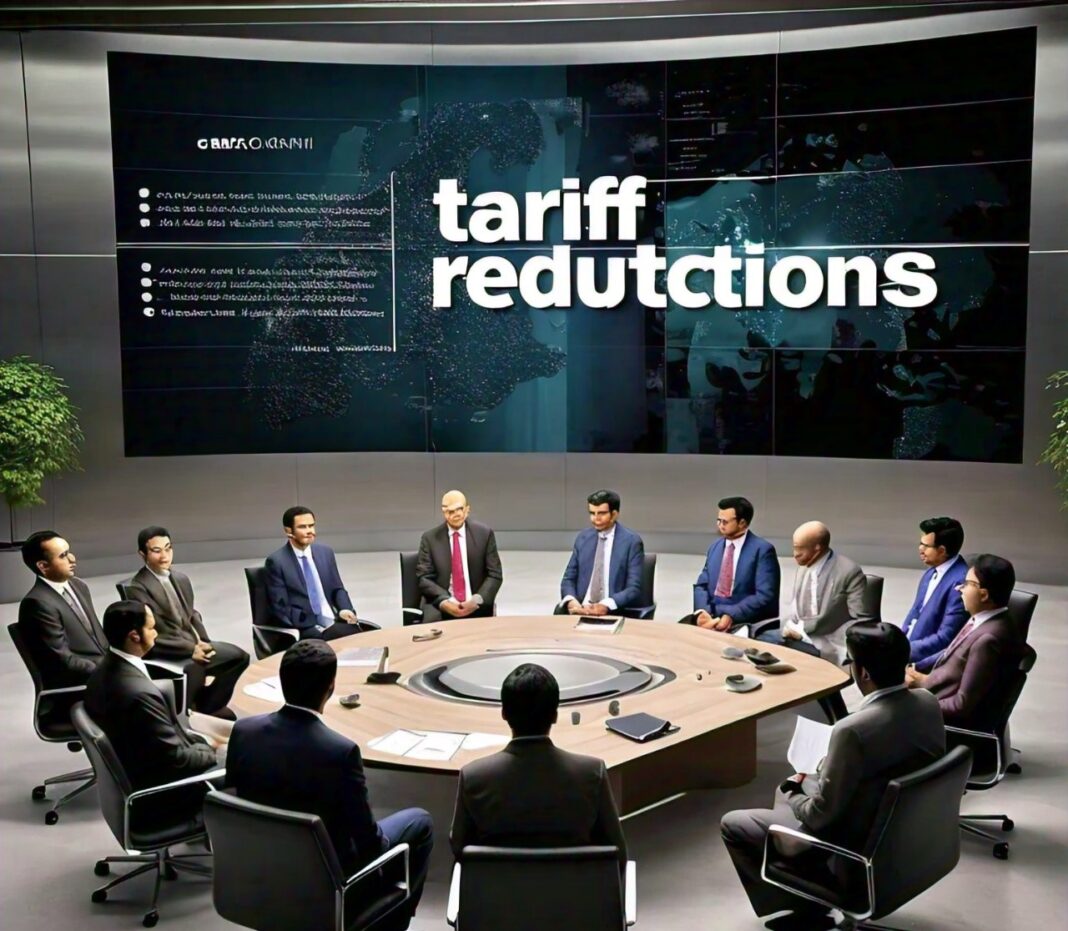In the ever-evolving landscape of global trade, tariff reductions have emerged as a pivotal factor influencing the competitiveness of exports. Tariffs, or taxes imposed on imported goods, have long been used by nations to protect domestic industries and regulate trade. However, the trend towards reducing these tariffs reflects a broader shift towards trade liberalization and economic integration.
The primary objective of tariff reductions is to lower the cost of exporting goods, making them more affordable and competitive in international markets. This, in turn, can lead to increased export volumes and enhanced revenue for businesses operating in a globalized economy. For economists and analysts, understanding how tariff reductions impact export competitiveness is crucial in assessing their broader economic implications.
This article aims to delve into how tariff reductions can boost export competitiveness, exploring the mechanisms through which they lower costs, open new market opportunities, and ultimately increase trade revenue. By examining historical examples, current trends, and the economic implications, this analysis will provide a comprehensive overview of how tariff policies can shape the success of a nation’s exports.
Definition and Types of Tariff Reductions
Tariff reductions refer to the decrease in taxes imposed by governments on imported goods. These reductions are often implemented through trade agreements, unilateral policy changes, or multilateral negotiations. There are several types of tariff reductions:
- Unilateral Reductions: A country independently lowers its tariffs without reciprocal actions from other nations. This approach can be used to stimulate trade and reduce the cost of imported goods.
- Bilateral Agreements: Tariff reductions resulting from agreements between two countries aimed at fostering trade between them. These agreements often involve concessions from both sides.
- Multilateral Agreements: Tariff reductions negotiated through international organizations such as the World Trade Organization (WTO), involving multiple countries. These agreements aim to reduce tariffs globally and promote fair trade practices.
- Regional Trade Agreements: Agreements between countries within a specific region, such as the European Union or the North American Free Trade Agreement (NAFTA), that involve collective tariff reductions to enhance regional trade.
Historical Context and Trends in Global Tariff Policies
The global landscape of tariff policies has evolved significantly over the past few decades. Historically, tariffs were used extensively to protect emerging industries and generate government revenue. However, the trend towards globalization and economic liberalization has led to a shift in tariff policies:
- Post-World War II Era: The establishment of the General Agreement on Tariffs and Trade (GATT) in 1947 marked the beginning of a concerted effort to reduce global tariffs and promote international trade. This was followed by successive rounds of negotiations aimed at lowering trade barriers.
- WTO Formation: The creation of the World Trade Organization (WTO) in 1995 replaced GATT and provided a more structured framework for negotiating tariff reductions and resolving trade disputes.
- Recent Trends: The past two decades have seen a significant reduction in average global tariff rates, driven by multilateral agreements and regional trade pacts. However, recent years have also witnessed a rise in trade protectionism and tariff disputes, reflecting a complex and often contentious global trade environment.
Also Read: The Impact of Trade Deficits on National Economies

Examples of Recent Significant Tariff Reductions
- US-China Phase One Trade Agreement (2020): As part of the Phase One Trade Agreement between the United States and China, both countries committed to reducing tariffs on certain goods to ease trade tensions and stimulate economic activity.
- European Union-Mercosur Trade Agreement (2019): The agreement between the European Union and Mercosur (a South American trade bloc) included significant tariff reductions aimed at increasing trade between the two regions.
- African Continental Free Trade Area (AfCFTA): Launched in 2021, the AfCFTA aims to reduce tariffs and facilitate trade across African countries, with the goal of boosting intra-African trade and economic integration.
Impact on Export Competitiveness
Analysis of How Reduced Tariffs Decrease Production Costs for Exporters
Tariff reductions play a crucial role in lowering production costs for exporters by decreasing the taxes on imported raw materials, components, and machinery. When tariffs are reduced, the cost of these imports falls, which can lead to several positive effects:
- Lower Input Costs: Reduced tariffs on raw materials and intermediate goods directly decrease the costs of production. For manufacturers relying on imported components, this reduction can lower their overall production expenses.
- Enhanced Profit Margins: With decreased production costs, exporters can either lower their prices to remain competitive or maintain their prices and increase profit margins. This flexibility can be crucial in price-sensitive markets.
- Improved Cost Efficiency: Lower tariffs can enable businesses to invest in more advanced or efficient production technologies, further reducing costs and improving overall efficiency.
Effects on Pricing Strategies and Profit Margins
The reduction in tariffs can significantly influence pricing strategies and profit margins for exporters:
- Competitive Pricing: With lower production costs, exporters can adopt more aggressive pricing strategies, offering lower prices to attract customers in competitive global markets.
- Increased Market Share: Competitive pricing can help exporters gain market share by making their products more affordable compared to those from countries with higher tariffs.
- Enhanced Profitability: Alternatively, exporters may choose to maintain their prices while benefiting from increased profit margins due to reduced costs. This approach can boost overall profitability and financial stability.
Market Expansion Opportunities
How Lower Tariffs Can Open New Markets and Increase Export Volumes
Reduced tariffs can create opportunities for exporters to expand into new markets and increase their export volumes:
- Access to Emerging Markets: Lower tariffs can make it more feasible for exporters to enter emerging markets where previously high tariffs may have been a barrier to entry.
- Increased Demand: By reducing prices through lower tariffs, exporters can stimulate demand for their products in both existing and new markets.
- Diversification of Export Destinations: With reduced costs and increased competitiveness, businesses can explore and establish new export destinations, reducing reliance on a limited number of markets.
Examples of Industries or Sectors Experiencing Growth Due to Tariff Reductions
Certain industries have experienced notable growth due to tariff reductions:
- Technology Sector: Reduced tariffs on technology components have allowed tech companies to lower their production costs and offer more competitive prices for electronics and software.
- Agricultural Products: Lower tariffs on agricultural imports have enabled countries to increase their export volumes of agricultural products, such as fruits, vegetables, and processed foods.
- Automotive Industry: Tariff reductions on automotive parts and vehicles have facilitated increased trade in the automotive sector, benefiting manufacturers and consumers alike.
Further Read: Why Emerging Markets Are the Next Frontier in International Trade

Enhanced Global Competitiveness
How Tariff Reductions Help Local Businesses Compete with International Firms
Tariff reductions can level the playing field for local businesses, enabling them to better compete with international firms:
- Cost Parity: By reducing the cost of imported goods and raw materials, local businesses can compete more effectively with foreign firms that previously had a cost advantage due to higher tariffs.
- Product Quality and Innovation: Lower costs can free up resources for local businesses to invest in product quality and innovation, further enhancing their competitive edge.
Economic Implications
Trade Revenue Growth
Exploration of How Increased Export Competitiveness Can Boost Trade Revenue
The link between increased export competitiveness and trade revenue growth is significant. When tariff reductions lead to enhanced competitiveness, several economic benefits can follow:
- Increased Export Volumes: As businesses lower their prices and become more competitive, they can expand their market share and boost export volumes. Higher export volumes often translate into increased trade revenue.
- Diversified Export Markets: By accessing new markets previously hindered by high tariffs, countries can broaden their export base, reducing dependency on a few markets and potentially increasing overall trade revenue.
- Economic Growth: The growth in trade revenue from enhanced export competitiveness can contribute to broader economic growth. Increased export activity supports domestic industries and can lead to higher GDP growth rates.

Statistical Analysis and Trends in Trade Revenue Post-Tariff Reductions
Empirical evidence often supports the positive impact of tariff reductions on trade revenue:
- Case Studies: Analyzing case studies from countries that have implemented significant tariff reductions can reveal trends in trade revenue growth. For example, studies have shown that countries participating in trade agreements with substantial tariff reductions often experience notable increases in export revenue.
- Economic Reports: Reports from international organizations, such as the World Trade Organization (WTO) and the International Monetary Fund (IMF), often provide data on how tariff changes influence trade revenue and overall economic performance.
Industry and Job Creation
Impact on Domestic Industries and Job Creation Resulting from Increased Export Activity
The ripple effects of increased export competitiveness extend beyond trade revenue to impact domestic industries and employment:
- Industry Growth: As exports grow, industries that produce export goods often experience increased demand, leading to business expansion and higher production levels.
- Job Creation: Increased export activity can drive job creation in various sectors, including manufacturing, logistics, and services. As businesses grow to meet higher export demand, they may hire more workers, contributing to reduced unemployment and stronger economic health.
Long-Term Economic Benefits for Local Economies
- Investment in Infrastructure: Higher export revenues can lead to increased investment in infrastructure, such as transportation and logistics, which supports further economic development.
- Improved Trade Balance: Enhanced export competitiveness can improve a country’s trade balance by increasing export revenues relative to import costs, contributing to a more balanced economy.
- Enhanced Economic Resilience: A diversified export base can make an economy more resilient to global economic fluctuations, providing stability and reducing vulnerability to economic shocks.
Also Read: How Trade Sanctions Are Affecting Global Markets
Suggestions for Policymakers on Implementing and Managing Tariff Reductions Effectively
For policymakers aiming to maximize the benefits of tariff reductions, several strategic considerations are crucial:
- Balanced Approach: Implement tariff reductions gradually and strategically to avoid disrupting domestic industries that may not be ready for increased competition. A phased approach can help mitigate negative impacts while reaping the benefits of lower tariffs.
- Complementary Policies: Pair tariff reductions with complementary policies such as support for affected industries, workforce development programs, and investment in infrastructure to ensure a comprehensive approach to economic growth.
- Monitoring and Evaluation: Establish mechanisms for continuous monitoring and evaluation of the effects of tariff reductions on different sectors. This helps in making data-driven adjustments and addressing any emerging challenges.
Risk Management
Potential Risks and Challenges Associated with Tariff Reductions
While tariff reductions offer significant benefits, they also come with potential risks and challenges:
- Industry Displacement: Certain domestic industries may struggle to compete with increased imports, leading to potential job losses and business closures. Identifying and supporting vulnerable sectors is essential to mitigate these risks.
- Trade Imbalances: Rapid tariff reductions can sometimes lead to trade imbalances if import growth outpaces export growth. Policymakers need to monitor trade balances closely and adjust policies as needed.
- Economic Disruption: Sudden changes in tariff policies can create economic disruptions, including market volatility and uncertainty. Gradual implementation and clear communication can help manage these disruptions.

Strategies for Mitigating Negative Impacts on Sensitive Industries
To address the potential negative impacts on sensitive industries:
- Support Programs: Implement support programs for industries that face challenges due to tariff reductions. These programs can include financial assistance, retraining initiatives, and support for innovation.
- Transition Assistance: Provide transition assistance to businesses and workers affected by tariff changes. This may include subsidies, grants, or tax incentives to ease the adjustment process.
- Stakeholder Engagement: Engage with stakeholders, including industry representatives and trade associations, to gather insights and address concerns related to tariff reductions. Collaborative approaches can help develop effective solutions and ensure a smoother transition.
Also Read: Trade Wars: The Future and What Lies Ahead
Conclusion
As global trade continues to evolve, the role of tariff reductions in shaping export competitiveness will remain a critical area of focus. Future research and analysis should consider:
- Evolving Trade Dynamics: Keeping abreast of changes in global trade dynamics, including new trade agreements and technological advancements, will be essential for understanding the ongoing impact of tariff reductions.
- Long-Term Effects: Evaluating the long-term effects of tariff reductions on various industries and economies will provide valuable insights into their sustained benefits and potential challenges.
In conclusion, tariff reductions offer significant opportunities for enhancing export competitiveness and driving economic growth. By leveraging these insights and staying informed about global trade developments, economists, analysts, and policymakers can effectively navigate the complex landscape of international trade and achieve their economic objectives.






